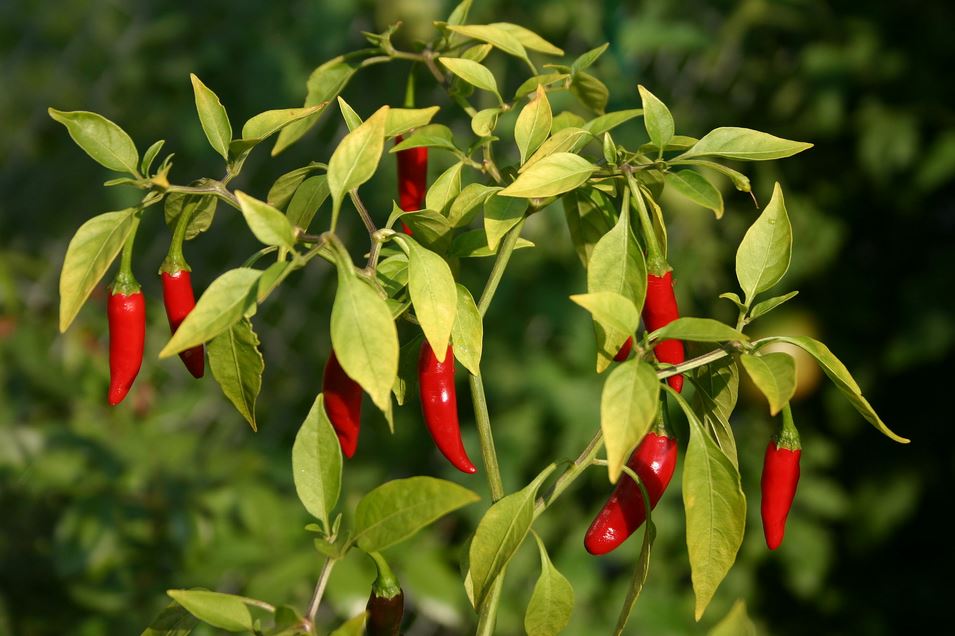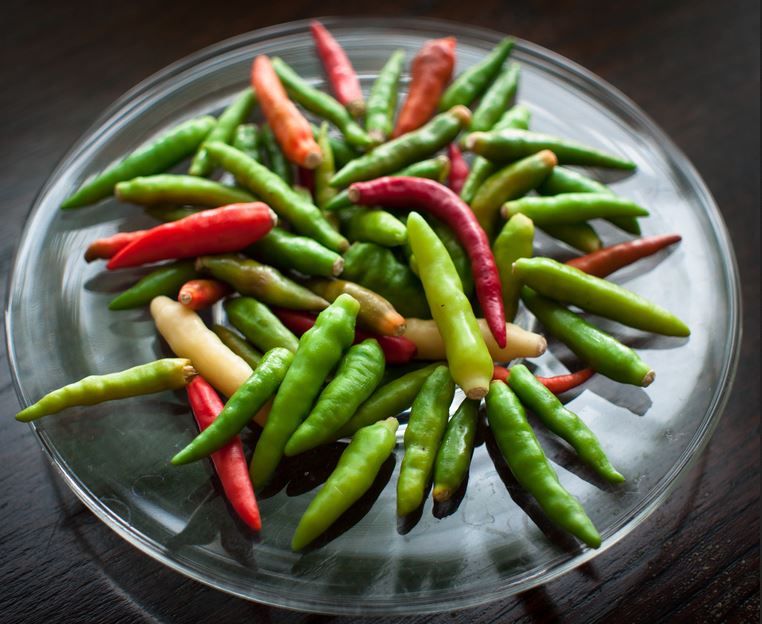Thai chili or bird’s eye chili is a type of chili pepper that belongs to the Capsicum annuum family and is indigenous to Mexico. If there are different kinds of grain, there are also different kinds of pepper. One of which is the Bird’s eye pepper. It is widely used in many Asian cuisines and is grown all over Southeast Asia. It might be mistaken for the cultivar “siling labuyo,” a chili of the Capsicum frutescens species with a similar appearance. The fruits of Capsicum frutescens are typically smaller and point upward.
A perennial, the bird’s eye chili plant bears small, tapering fruits, frequently two or three at a node. The fruits have a strong flavor. The tiny but extremely hot bird’s eye chili (piquant). It measures between 50,000 and 100,000 Scoville units, which is considerably hotter than a typical jalapeño but at the lower end of the range for the hotter habaneros.
The Origin of Bird’s Eye Chili Pepper
All varieties of chilies grown today originated in Mexico, Central America, and South America. Through the Columbian Exchange, they were disseminated by Spanish and Portuguese colonists, missionaries, and traders alongside many other now-common crops like maize, tomatoes, and pineapples. The 16th or 17th century saw the introduction of the chili varieties that can be found today in Southeast Asia.
Uses of Bird’s Eye Chili Pepper
As Food
These chilies are frequently used in many different dishes and sambals in Indonesian cuisine. These chilies are used in soups, salads, and stir-fried dishes in Vietnamese cooking. Additionally, a variety of sauces, pastes, and marinades are made with them, and they are consumed raw, both fresh and dried, as a condiment..
These chilis are prized in Thai cuisine for their intense spiciness and fruity flavor. They can be eaten raw on the side with dishes like khao kha mu, which is a stewed pork trotter served with rice, or they can be used extensively in many Thai dishes, such as Thai curries and salads, using both green and ripe red chilis. It’s good to eat these kind of dishes because there are lots of benefits in consuming peppers.
As Ornamentals
The “Thai ornamental” chili, which is sometimes more ornamental but a little less spicy, has peppers that point upward on the plant and change color from green to yellow to orange to red. It serves as the foundation for the hybrid cultivar “Numex twilight,” which is essentially the same but less pungent and begins with purple fruit to produce a rainbow effect. There are places like Saipan and Guam where these peppers can grow wild.
How Hot Is A Bird’s Eye Chili?
On the Scoville Scale, bird’s eye chilis have a Scoville heat rating between 50,000 and 100,000. When compared to a typical jalapeno pepper, which has an average SHU of 5,000, the bird’s eye pepper is ten to twenty times hotter. There’s a lot of heat there.
Cooking With Bird’s Eye Chili Pepper
The cuisines of many nations surrounding Thailand as well as Thai cuisine frequently use bird’s eye peppers. They taste great and really deliver a punch. The plants are consistently fruitful and I’ve grown these pods in my garden a few times now. These peppers are perfect for making hot sauces, chili pastes, salsas, or for dehydrating and grinding into chili flakes or chili powders because of their abundance, good level of heat, and vibrant color. They’re also tasty when added to salads, soups, and stir-fries.
The Chili Type Of Bird’s Eye Pepper
The fact that seeds and plants can occasionally be categorized as Capsicum annuum or Capsicum frutescens is somewhat perplexing. But you can quickly identify the species. Birds Eye chili plants resemble one eye to the other at first glance. They have narrow fruits on small, bushy plants. The pods are approximately 5 cm long and 1 cm in diameter.
The Capsicum Annum Of Bird’s Eye Pepper
The chilli peppers of the Capsicum annuum species hang downward. Other than that, they are identical to those of the Frutescens species in length and diameter. Additionally, they are sharp to about 100.000 SHU. But it’s also possible to reach 225.000 SHU. Thai Hot, Indonesia, Laos, and Vietnam all have larger cultivation areas. Unless otherwise stated, the Capsicum frutescens species will be referred to in the text below. An example of a Capsicum frutescens species is shown in the image above. This is distinguishable by the upward-facing flowers and pods.
The Capsicum Frutescens Of Bird’s Eye Pepper
The chili peppers on the Capsicum frutescens species’ “birds eye” chilies are partially pointed upward. The chilies grow in all directions like Tabasco. Some of them point upward and are as straight as a die. So, it is a species that can survive for more than five years. It can grow to a height of more than two meters in some circumstances. The Indian states of Meghalaya and Assam have larger farming areas. The Scoville heat level of ripe pods is about 100,000. An advantageous ingredient in the kitchen in the land of pungency.
Bird’s Eye Chili Pepper’s Scoville And Degree of Sharpness
Birds Eye chilis have 100,000 Scoville Heat Units on the Scoville scale. This should be categorized as having a sharpness of 9. With 50,000 Scoville, Tabasco chili pods are only half as hot. With up to 225,000 SHU, Thai Birdseye chili peppers can shoot the bird. According to this, there is a low degree of sharpness of 10.
The Cultivation of Bird’s Eye Chili Pepper
They should be planted from seeds in January or February. The chilies can grow well on the windowsill of a south window up until mid-May. The plants will grow faster and healthier with more light. Periodically incorporate exercise into your cultivation. Plants grow unsteadily in the home. Use a ventilator that you activate once or twice per week to avoid this. You can purchase fresh Thai Dragons seeds from the Asia Shop for cultivation. Various dealers in chili seeds can supply you with pure seeds. You can buy dried seeds there, which typically last for several years. These are, at best, soaked. Several chili farmers drink chamomile tea. We always drink lemon water. Here is more information on soaking seeds.
The Germination of Bird’s Eye Chili Pepper
The seeds in a greenhouse begin to sprout after about 14 days. A temperature of 25 °C is adequate for germination. For a few euros, a simple windowsill greenhouse might be sufficient. then pay attention to a warm area. Manual detection of cold or warm areas at windows works best. Use sponge rubber, foam, or paper to insulate the greenhouse’s underside if necessary. More dependable is a heated greenhouse. You will undoubtedly obtain one if you have chili fever. You can grow cultivars that are hard to draw in thanks to this. It is neither particularly simple nor particularly difficult to germinate birds’ eyes. If you have a choice, 25 to 28 degrees Celsius is a good range to choose from.
Caring for Bird’s Eye Chili Pepper
When taking care of chilies, four things are especially crucial. Warmth, light, loose soil, water, and fertilizer would be those things. Chilies are wiped out by waterlogging. With a well-structured soil, you can prevent this. This must allow air to reach the roots and must not cardboard together. For instance, combining coconut fibers with tomato soil ensures healthy root development. Never overwater a plant. Please read this article to learn how to tell when fresh water is needed. You can learn all the information you require about water there as well. The Caribbean is where chilies first appeared. Warm climates in Asia and Africa support the growth of bird eye chilies. Choose a location with a comfortable level of warmth, humidity, and light to honor the plant. Utilize plant lights to your advantage during the gloomy winter months.


